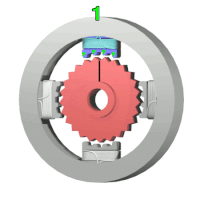
Photo from wikipedia
Quantitative assessment of motor function is increasingly applied in fall risk stratification, diagnosis, and disease monitoring of neuro-geriatric disorders of balance and gait. Its broad application, however, demands for low-cost… Click to show full abstract
Quantitative assessment of motor function is increasingly applied in fall risk stratification, diagnosis, and disease monitoring of neuro-geriatric disorders of balance and gait. Its broad application, however, demands for low-cost and easy to use solutions that facilitate high-quality assessment outside laboratory settings. In this study, we validated in 30 healthy adults (12 female, age: 32.5 [22 – 62] years) the performance and accuracy of the latest generation of the Microsoft RGB-D camera, i.e., Azure Kinect (AK), in tracking body motion and providing estimates of clinical measures that characterise static posture, postural transitions, and locomotor function. The accuracy and repeatability of AK recordings was validated with a clinical reference standard multi-camera motion capture system (Qualisys) and compared to its predecessor Kinect version 2 (K2). Motion signal quality was evaluated by Pearson’s correlation and signal-to-noise ratios while the accuracy of estimated clinical parameters was described by absolute and relative agreement based on intraclass correlation coefficients. The accuracy of AK-based body motion signals was moderate to excellent (RMSE 89 to 20 mm) and depended on the dimension of motion (highest for anterior-posterior dimension), the body region (highest for wrists and elbows, lowest for ankles and feet), and the specific motor task (highest for stand up and sit down, lowest for quiet standing). Most derived clinical parameters showed good to excellent accuracy (r .84 to .99) and repeatability (ICC(1,1) .55 to .94). The overall performance and limitations of body tracking by AK were comparable to its predecessor K2 in a cohort of young healthy adults. The observed accuracy and repeatability of AK-based evaluation of motor function indicate the potential for a broad application of high-quality and long-term monitoring of balance and gait in different non-specialised environments such as medical practices, nursing homes or community centres.
Journal Title: PLOS ONE
Year Published: 2023
Link to full text (if available)
Share on Social Media: Sign Up to like & get
recommendations!